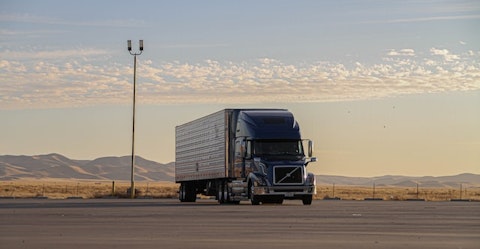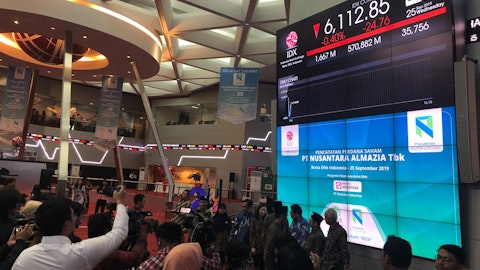Saia, Inc. (NASDAQ:SAIA) Q4 2022 Earnings Call Transcript February 3, 2023
Operator: Good morning. My name is Devin, and I will be your conference operator today. At this time, I would like to welcome everyone to the Saia, Inc. Fourth Quarter and Annual Meeting Conference Call. After the speakers’ remarks there will be a question-and-answer session. Thank you for your patience. I will now turn the call over to Doug Col, Saia’s Executive President and Chief Financial Officer. Please go ahead.
Doug Col: Thanks, Devin. This is Doug Col, I’m Saia’s Executive Vice President and Chief Financial Officer. With me for today’s call is Fritz Holzgrefe, our President and Chief Executive Officer. Before we begin, you should note that during the call, we may make some forward-looking statements within the meaning of the Private Securities Litigation Reform Act of 1995. These forward-looking statements and all other statements that might be made on this call that are not historical facts are subject to a number of risks and uncertainties, and our actual results may differ materially. We refer you to our press release and our SEC filings for more information on these exact risk factors that could cause actual results to differ. I will now turn the call over to Fritz for some opening comments.
Fritz Holzgrefe: Good morning, and thank you for joining us to discuss Saia’s fourth quarter and record full-year results. Before I get into the discussion of fourth quarter results, I want to take a minute and express my thanks to the entire team here at Saia for what we achieved together in 2022. The year brought an additional 11 new terminals into our network and our team grew by more than 500 employees during the year. Most importantly, we kept the customer first and continue to provide leading service to our customers in doing so achieved record sales and earnings for the full-year. Thanks to all of our Saia associates, who had a hand in these record results. Moving on to our recent results. December brought a continuation of the negative volume trends we experienced across the back half of 2022.
In the fourth quarter, we averaged approximately 28,400 shipments per day, about 8.2% fewer shipments per day than in the same quarter last year and down from 30,500 shipments per day averaged in the third quarter. Wafer shipment increased modestly, so overall tonnage was down 7.7%. The slowing industrial environment as evidenced by numerous reports influenced these results across all of our business. On a brighter note though, pricing remains stable and our fourth quarter yield excluding fuel surcharge grew by 6.5% and revenue per shipment excluding fuel surcharge increased by 7.1%. Total fourth quarter revenue rose by 6.3% to $655 million. Our continued strong service performance supported the contractual renewal increase of 7.4% in the fourth quarter.

Photo by Sander Yigin on Unsplash
The contractual renewals reflected deceleration from the trend of the past several quarters and should be expected given the softer volume environment, but solid number nonetheless. On a full-year basis in 2022, total revenue of $2.8 billion was a record for Saia, it was up 22% from the prior year. Operating income rose 40% for the year to $470.5 million and our operating ratio of 83.1% was 230 basis points improved from 2021. This was the best year in our nearly 100-year operating history. As we move into 2023, we’ve continued to see announced general rate increases across the market and that are in the mid-single-digit range. And here at Saia, we implemented a general rate increase this past Monday, which averages approximately 6.5% across impacted customers.
At the same time, our service indicators remain very strong across the business. We’re committed to providing excellent service to our customers and are invested heavily in the business to expand coverage and it’s gratifying to see that our customers see the value in our service offering and GRI allows us to partially offset the rising cost of investing in people, equipment, technology and our growing service footprint. Our fourth quarter operating ratio of 85.9% increased by 170 basis points, compared to our operating ratio of 84.2% posted in the fourth quarter of last year. I’ll now turn the call over to Doug for more details from our fourth quarter and full-year financial results.
Doug Col: Thanks, Fritz. As mentioned, fourth quarter revenue increased by $38.6 million to $655.7 million. The components of revenue growth in the quarter versus the fourth quarter a year ago were as follows: our yield excluding fuel surcharge improved by 6.5% and yield increased by 14.3%, including the fuel surcharge. Fuel surcharge revenue increased by 46.4% and was 20.1% of total revenue, compared to 14.6% in last year’s fourth quarter. Revenue per shipment excluding fuel surcharge was 7.1% to $288.34 and including fuel surcharge, revenue per shipment rose 15% to $364.44. Tonnage decreased 7.7% attributable to an 8.2% shipment decline slightly offset by a 0.5% increase in our average weight per shipment. Our length of haul decreased 3.5% to 892 miles.
A further breakdown of activity in the quarter is as follows. In October, our shipments were down 4.4% and tonnage was down 3% with a 1.4% increase in weight per shipment. In November, shipments were down 8.1%, tonnage was down 7.1% and weight per shipment rose 1.1%. December shipments were down 12.3% and tonnage was down 13.2% with weight per shipment turning negative down 1% in December. In January, shipments have been down — were down 3.9% and tonnage was down 3.7% with weight per shipment up slightly 0.2%. Shifting to the expense side for a few key items to note in the quarter, and how they moved with the acceleration of negative volume trends we experienced. Salaries, wages and benefits increased by 5.3% from a combination of our July wage increase, which averaged about approximately 4.3% across our employee base and also the result of our employee count having grown by approximately 5.7% year-over-year.
Purchase transportation expense decreased by 13.8%, compared to last year and was 9.2% of total revenue, compared to 11.3% in the fourth quarter of 2021. Truck and rail purchase transportation miles combined were 12% of our total line haul models in the quarter, compared to 19.5% in the fourth quarter of 2021 and compared sequentially to Q3 miles of 17%. Fuel expense increased by 41.5% in the quarter, while company miles increased 4.3% year-over-year. The increase in fuel expense was primarily the result of national average diesel prices rising more than 38% on a year-over-year basis. Clients and insurance expense decreased by 8% year-over-year in the quarter and was down 2$ or $0.3 million sequentially from the third quarter. Depreciation expense of $39.6 million in the quarter was 10.3% higher year-over-year, primarily related to investments in real estate and equipment.
Total operating expenses increased by 8.3% in the quarter and with a year-over-year revenue increase of 6.3%, our operating ratio increased by 170 basis points to 85.9%, compared to 84.2% a year ago. Our fourth quarter tax rate of 24%, compared to 23.9% in the fourth quarter last year and our diluted earnings per share were $2.65, compared to $2.76 in the fourth quarter a year ago. Moving on to financial highlights of our full-year 2022 results. As Fritz mentioned, revenue was a record $2.8 billion and operating income of $470.5 million was also an annual record. Our operating ratio improved 230 basis points in the year to a record 83.1%. For the full-year 2022, our diluted earnings per share were a record $13.40, compared to $9.48 in 2021.
I’ll now turn the call back over to Fritz for some closing comments.
Fritz Holzgrefe: Thanks, Doug. While the environment certainly feels a bit more tempered to us than it did entering the past couple of years, I feel pretty optimistic about the road ahead. The December volume decline was a bit more pronounced than what we would have expected from a seasonality standpoint. But we do like — feel like some of that may have been the result of inclement weather that moved across the country over the last week or so in December. The extreme temperatures have resulted in some customers working limited schedules and we saw that reduce pickups. As we turn the calendar January volumes are catching up a bit better than expected, maybe the result of some catch-up from customers. If history holds, there’ll be more weather effects as we move through the next month and get into warmer temperatures in our seasonally busier months of the year.
However, as we’ve learned over the past several years, that the environment is disrupted by weather or other events, the carrier that has the ability to adjust and restore service will continue to be a strategic partner of the customer’s supply chain. In terms of expectations, we have plans to open five terminals over the next three to four months. And look forward to the expanded service and presence these terminals will give us. At the same time, we continue to develop the markets around the 18 facilities that we have opened over the last two years. Although we’re excited by the early success of these locations, we see considerable runway to continue and penetrate those markets. Beyond that, we continue to work through a pipeline of more than 30 real estate projects, which are under review and consideration as potential openings over the next several years.
These terminal openings support our strategy of getting closer to the customer and adding value to the supply chain. With that said, we’re open — ready to open the line to questions, operator?
See also Buffett Stock Portfolio: Recent Buys and 13 Best Value Dividend Stocks to Buy .
Q&A Session
Follow Saia Inc (NASDAQ:SAIA)
Follow Saia Inc (NASDAQ:SAIA)
Operator: Our first question comes from Todd Fowler with KeyBanc Capital Markets.
Todd Fowler: Hey, great. Good morning, Fritz. Good morning, Doug. Thanks for taking the question. So Fritz, it sounds like you just covered a little bit of the January trends and it feels like maybe if there’s some movement between late December and into January. But I guess, I’m just curious in this environment how you think about managing the staffing levels with kind of the volatility and freight as you think about margin progression either into the first quarter or even on a full-year basis in 2023? What would your expectations be just given kind of where the environment is?
Fritz Holzgrefe: Yes. I think the key thing for us, Todd, we describe the impacts that we saw with weather in December and just the last few days of January, you actually saw the weather trends in the center of the country and as you would effect that had — that influence the results we have. But the key thing that we think about with any of this is that we want to manage our labor cost to match, sort of, what we need to do to deliver leading or exceeding service for our customers. So as we’ve gone through this last few months as we’ve seen the trends, we’ve reset kind of our cost model. You see us in sourcing more and more of our line haul costs versus what we had been doing, looking for opportunities to leverage our city drivers into our line haul network to maximize the utilization of all those important assets.
Those are the — those people are key to driving the success for us as we come out of weather events or slower economic events and be able to match customers’ needs and expectations or frankly exceed them. So we feel like that, that we’re continue to position ourselves for that. We’ve looked at the history of what we’ve seen sort of quarter-to-quarter from Q4 to Q1. We feel like we can keep that kind of in line with historic, sort of, seasonality there to keep the OR flat, maybe it gets better, if things get a little bit better. But I think we continue to manage to maintain service and we optimize and match our labor costs to what the environment affords us. So full-year, it’s still — it will be interesting to see how this develops as to where this ends up, but I that we’re in a position that we know that we’re providing differentiated service, that’s going to allow us and the environment certainly is going to continue to allow us to price for that.
And I think that’s going to be an important part of how we manage the overall investment in the business.
Todd Fowler: Yes, okay. Thanks, Fritz. And maybe just to that last point, and I’ll turn it over after this. But on the pricing side and you talked about the contract renewals coming in I think at 7.4% and that’s down from what we’ve seen over the last couple of quarters, which have been very strong. Can you just speak to where you think you’re at with your pricing ability based on your service improvements and the network and maybe your ability to kind of continue close that pricing gap as you’ve made those investments and improve the service over the last several years? Thanks a lot.



